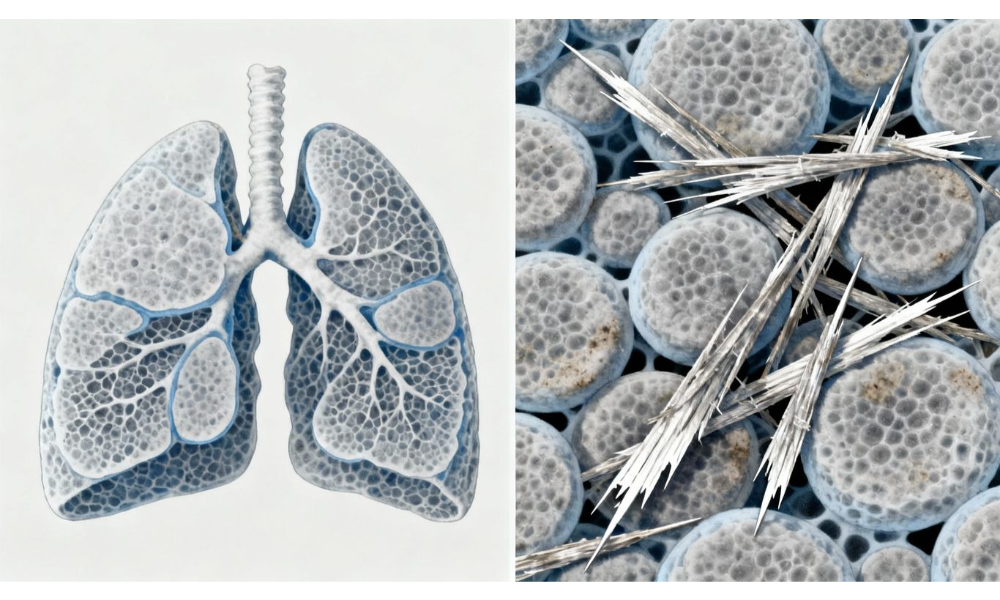The Link Between Asbestos Exposure and Lung Cancer
Asbestos, a group of naturally occurring minerals, was once widely used in construction and manufacturing due to its heat resistance and insulating properties. However, its widespread use has led to significant health concerns, most notably an increased risk of lung cancer. When asbestos-containing materials are disturbed, tiny fibers are released into the air and can be inhaled. These microscopic fibers can lodge deep within the lungs, setting the stage for long-term health problems. The connection between asbestos exposure and lung cancer is well-established, with individuals who have worked in industries involving asbestos, such as shipbuilding, mining, and construction, facing a higher risk. It’s important to understand that the latency period for asbestos-related diseases can be very long, often appearing 15 to 40 years or more after initial exposure. This makes it difficult to immediately connect past work environments with current health issues. For those dealing with potential asbestos contamination, hiring licensed professionals for asbestos handling is a critical step in preventing exposure.
How Asbestos Fibers Cause Cellular Damage
Once inhaled, asbestos fibers can cause damage to lung tissue in several ways. Their shape and durability play a significant role. These fibers are sharp and needle-like, allowing them to penetrate lung cells. Once inside, they can trigger chronic inflammation. This ongoing inflammation is a key factor in the development of cancer. The body tries to remove these foreign invaders, but the fibers are resistant to breakdown. This persistent irritation can lead to genetic mutations in lung cells over time. These mutations can cause cells to grow uncontrollably, forming tumors. The body’s immune response, while intended to protect, can inadvertently contribute to the carcinogenic process through the release of reactive oxygen species during inflammation, which can damage DNA. The specific type and size of asbestos fiber, along with the duration and intensity of exposure, influence the extent of cellular damage.
Factors Influencing Risk of Asbestos Induced Lung Cancer
Several factors can influence an individual’s risk of developing lung cancer after asbestos exposure. The intensity and duration of exposure are primary determinants; longer and more intense exposures generally lead to a higher risk. The type of asbestos fiber also plays a role, with amphibole fibers (like amosite and crocidolite) often considered more dangerous than serpentine fibers (like chrysotile). Smoking dramatically increases the risk of lung cancer in individuals exposed to asbestos. The combined effect of smoking and asbestos exposure is synergistic, meaning the risk is far greater than the sum of the individual risks. Genetic predisposition may also play a part, with some individuals being more susceptible to the carcinogenic effects of asbestos than others. Understanding these contributing factors is vital for assessing individual risk and implementing appropriate preventative measures.
Recognizing The Symptoms of Asbestos Induced Lung Cancer
Early Warning Signs and Their Significance
It’s not always easy to spot lung cancer early, especially when it’s linked to asbestos. Often, the symptoms don’t show up until the disease has progressed. This is why paying attention to even small changes in your health is so important. Don’t brush off persistent issues, even if they seem minor at first. Early detection can make a significant difference in treatment outcomes. Sometimes, a persistent cough that won’t go away is the first sign. Other times, it might be a change in how you breathe or a general feeling of being unwell.
Respiratory Symptoms Associated with Asbestos
When asbestos fibers get into the lungs, they can cause a lot of irritation and damage over time. This can lead to a variety of breathing problems. You might notice:
- A cough that doesn’t stop, sometimes bringing up mucus or even blood.
- Shortness of breath, especially when you’re doing things that used to be easy.
- Wheezing, which is a whistling sound when you breathe.
- Chest pain, which might feel worse when you breathe deeply, cough, or laugh.
These respiratory issues are common because the lungs are directly affected by the asbestos fibers.
Other Potential Indicators of Lung Cancer
Beyond breathing problems, lung cancer from asbestos can show up in other ways too. It’s a good idea to be aware of these less obvious signs:
- Unexplained weight loss: Losing weight without trying can be a sign that something is wrong.
- Fatigue: Feeling unusually tired or lacking energy, even after resting.
- Hoarseness: Your voice might change or sound deeper.
- Frequent lung infections: Like pneumonia or bronchitis that keeps coming back.
- Swelling in the face or neck: This can happen if a tumor presses on certain nerves or blood vessels.
Diagnostic Procedures for Asbestos Induced Lung Cancer
Figuring out if someone has lung cancer caused by asbestos isn’t always straightforward. It takes a careful look by medical professionals. They need to gather a lot of information to get to the bottom of it. The diagnostic process is designed to confirm the presence of cancer and identify its specific cause.
Medical History and Physical Examination
When you first see a doctor about concerns, they’ll start by asking a lot of questions. This includes your work history, especially if you’ve ever been around asbestos. They’ll want to know about any past illnesses and your general health. A physical exam follows, where the doctor will listen to your lungs and heart and check for any unusual signs. This initial step is important for building a picture of your health and potential exposures. It helps them understand what might be going on and guides the next steps in the diagnostic journey. Learning about your past exposures is key to understanding potential health risks.
Imaging Techniques for Lung Assessment
After the initial check-up, doctors often use imaging tests to get a look inside your chest. These can help spot any abnormalities in the lungs. Common tests include:
- Chest X-rays: These provide a basic image of your lungs, heart, and chest wall. They can sometimes show larger tumors or fluid buildup.
- CT Scans (Computed Tomography): These give more detailed cross-sectional images of the lungs. CT scans are better at detecting smaller nodules or changes that might be missed on an X-ray. They can also help see if cancer has spread to nearby lymph nodes.
- PET Scans (Positron Emission Tomography): These scans can help determine if a suspicious area is cancerous and if the cancer has spread to other parts of the body. They work by detecting areas of high metabolic activity, which is common in cancer cells.
These imaging methods are vital for visualizing the lungs and identifying suspicious areas that need further investigation. They are a cornerstone in the process of diagnosing lung conditions, including those linked to asbestos exposure.
Biopsy and Pathological Analysis
If imaging tests show something concerning, the next step is usually a biopsy. This involves taking a small sample of tissue from the suspicious area in the lung. The sample is then sent to a lab for examination under a microscope by a pathologist. This is the only way to definitively confirm if cancer is present and to determine its type. There are several ways a biopsy can be performed:
- Bronchoscopy: A thin, flexible tube with a camera is inserted into the airways to visualize and take samples.
- Needle Biopsy: A needle is used to extract tissue, often guided by CT scans.
- Surgical Biopsy: In some cases, a small surgical procedure might be needed to obtain a larger tissue sample.
The results of the biopsy are critical. They not only confirm the diagnosis of lung cancer but also provide information about the specific cell type, which is important for planning the most effective treatment. Pathological analysis can also sometimes reveal signs of asbestos-related damage, further supporting the diagnosis of asbestos-induced lung cancer.
Treatment Strategies for Asbestos Induced Lung Cancer
When it comes to treating lung cancer that’s been brought on by asbestos exposure, the approach is often multi-faceted. Doctors consider a number of things when figuring out the best plan, like the stage of the cancer, the patient’s overall health, and what treatments they’ve had before. The goal is to manage the disease and improve the patient’s quality of life.
Surgical Interventions and Their Applicability
Surgery might be an option for some patients, particularly if the cancer is found early and hasn’t spread much. The type of surgery depends on where the tumor is and how big it is. Sometimes, doctors can remove just a small part of the lung, while other times, a larger section or even a whole lung might need to be taken out. It’s a big decision, and not everyone is a candidate for surgery. The recovery can be tough, but for the right person, it can offer a good chance at removing the cancer.
Chemotherapy and Radiation Therapy Options
Chemotherapy uses drugs to kill cancer cells, and it can be given in different ways – through an IV or as pills. It’s often used when cancer has spread or when surgery isn’t possible. Radiation therapy uses high-energy rays to target and destroy cancer cells. It can be used on its own, with chemotherapy, or after surgery. These treatments can have side effects, like fatigue and nausea, but doctors work hard to manage them. Patients often find that a combination of these therapies can be quite effective in controlling the spread of the disease. You can find more information on common mesothelioma treatment options here.
Targeted Therapies and Immunotherapy
More recently, treatments have become more specific. Targeted therapies focus on specific changes in cancer cells that help them grow and survive. These drugs are designed to attack those specific changes, often with fewer side effects than traditional chemotherapy. Immunotherapy is another exciting area. It works by helping the body’s own immune system recognize and fight cancer cells. These newer approaches are showing promise for many patients, offering new hope when other treatments haven’t worked as well. The choice of treatment is always a conversation between the patient and their medical team.
Prognosis and Long-Term Management
Factors Affecting Patient Outcomes
The outlook for individuals diagnosed with asbestos-induced lung cancer isn’t a simple one-size-fits-all answer. Several elements play a significant role in how a patient might fare over time. The stage at which the cancer is detected is a major factor; earlier detection generally leads to better prospects. The specific type of asbestos-induced lung cancer also matters, as some forms are more aggressive than others. Furthermore, the patient’s overall health before diagnosis, including the presence of other lung conditions like asbestosis or COPD, can influence treatment effectiveness and recovery. The extent of asbestos exposure, including the duration and intensity, also contributes to the overall prognosis.
Palliative Care and Symptom Relief
When dealing with asbestos-induced lung cancer, managing symptoms is a big part of the treatment plan. Palliative care isn’t just about the end of life; it’s about improving quality of life at any stage of the illness. This can involve a range of approaches aimed at easing discomfort and distress.
- Pain Management: Medications and other techniques can help control pain associated with the cancer.
- Breathing Support: Oxygen therapy or breathing exercises might be used to help with shortness of breath.
- Nutritional Guidance: Advice on maintaining good nutrition can support overall well-being.
- Emotional Support: Counseling and support groups can help patients and their families cope with the emotional challenges.
Ongoing Monitoring and Follow-Up
After initial treatment, regular check-ups are really important. These appointments allow doctors to keep an eye on how the patient is doing and to catch any signs of the cancer returning or spreading. This follow-up care is a key part of managing the disease long-term.
- Regular Imaging: Chest X-rays or CT scans are often used to monitor the lungs.
- Blood Tests: Certain blood markers might be checked.
- Physical Exams: Doctors will assess the patient’s general health and any lingering symptoms.
- Discussion of Concerns: Patients have the opportunity to discuss any new or worsening symptoms with their healthcare team.

